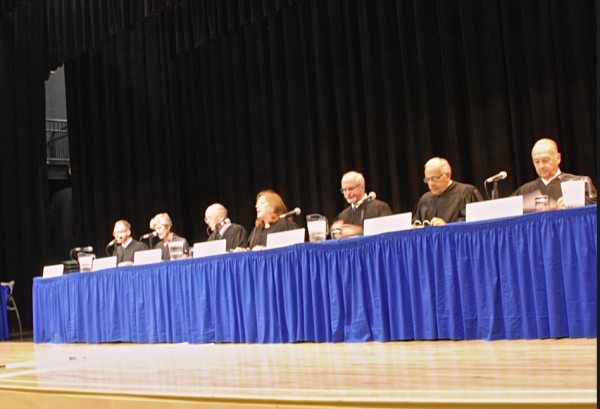

FARMINGTON – After hearing the oral arguments in three appellate cases before members of the Maine Supreme Judicial Court held at Mt. Blue High School, students said they found the proceeding interesting, not what they expected and had plenty of questions of their own about the cases.
On Wednesday morning, nearly 750 Mt. Blue students, along with 20 visiting Mt. Abram High School students, were given the opportunity to hear one of three cases argued before the seven justices of Maine’s highest court. Three additional advanced placement U.S. history and pre-law classes attended all three arguments. A video feed was played in the library for more students and staff to view the proceedings.
Students had received copies of the parties’ legal briefs before the oral arguments, and after the oral arguments the lawyers stayed to answer questions from students.
For a decade, the justices have moved their courtroom to three high schools each year in October, allowing students to get a real life look at how the court system works at the highest level in the state. It’s something few people have a chance to see.
Bringing the courtroom to schools provides an important civics lesson, said Chief Justice Leigh Saufley before court was in session.
“We are the government. This is a chance to see the judicial branch and how it works,” she said. “Civic lessons are very important.” She also noted that students see what the justices, attorneys arguing the cases and court marshals do and that may inspire some of them to pursue a career in law.
The music room down a hall from the auditorium’s stage door served as the judges’ chambers. The auditorium’s stage held a long skirted table labeled with each justice’s name next to a microphone.
The attorneys arguing the cases had small tables set apart below the stage. The courtroom needed to be replicated just so, including the order of where the justices sit, according to Principal Bruce Mochamer.
“The is court, this is the Maine Supreme Court,” he said watching faculty and staff run through the final sound checks. Saufley said she appreciated the challenge each school undergoes to bring the court to students and the formal decorum required of the proceeding.
Attorney Paul Mills of Farmington offered students an overview of each case before court was called into session and procedural instructions such as to stand at “all rise” in deference to the justices as they enter and leave the “courtroom.”
Before court, Saufley told the students that silence is the rule but allowed for “wild applause,” she said, to thank all those who helped bring and create the courtroom at Mt. Blue, which included state Sen. Tom Saviello of Wilton, who invited the justices to Farmington.
Then the court was called into session. The first case, State of Maine v. John E. Sasso, argued that a motion to suppress granted by a judge that resulted in operating after suspension charge should be overturned. The reason, Sasso’s lawyer Ezra A. R. Willey argued, was that the police officer said he pulled the car over because one of the brake lights stayed on and appeared brighter than the other when both tail lights were lit. The stop, he said was not justified and resulted in the discovery he was operating without a a valid driver’s license.
The state’s attorney, Delwyn E. Webster, argued the stop by the officer was justified by a reasonable, articulable suspicion, in that one light, always on, could be a safety hazard if it were mistaken for braking.
Saufley said that while the officer said it was a tail light, he actually stopped the car because he believed there was underage drinking. The driver, Sasso was 18 years old at the time.
After peppering Sasso’s attorney with more questions, the justices turned their attention to state’s attorney. Saufley immediately asked about the four other police officers that appeared at the stop, asking if this had been a patrol detail to catch intoxicated drivers.
“The real purpose of the stop was to check for underage drinking,” said Justice Joseph Jabar. “You need five officers because of a tail light?”
Webster repeated the light was a safety hazard and the officer thought the break light was stuck on.
“Is that a justification for stopping the vehicle?” Jabar asked. Justices Saufley, Andrew Mead and Thomas Humphrey appeared to agree that a brighter tail light may not be reason enough for making a stop.
“Society doesn’t just want people to get stopped for no reason,” Mead said.
Afterward, when court was in recess, students asked the attorneys arguing the case some questions, including how someone could have violated the law if both tail lights were working.
The second case involved an operating under the influence conviction in which a driver was observed by a police officer to be operating his vehicle on the left side of the road. The driver said he was driving in the opposite lane to avoid potholes in the road. He left a bar after 1 a.m. and was followed by a police officer before getting pulled over.
In State of Maine v. James Morrison, the defendant argued the traffic stop and subsequent arrest violated his constitutional right to be free from unreasonable searches that included a field sobriety test that led to an intoxilyzer test just because he was driving to avoid potholes.
The justices questioned attorney Willey, also arguing for Morrison in the second case, that driving on the wrong side of the road wasn’t reason enough for an officer to stop the vehicle. Justices noted was that the officer reported the driver’s eyes were droopy, his speech was slurred and he admitted he had had two beers.
After watching a video of the field sobriety test, Justice Ellen Gorman said they found the officers description to be accurate.
Willey said his client speaks in a “thick Downeast accent” and that had the officer followed his client further to where the road is in better condition, he would have seen better driving.
Justices said what if the officer had waited to pull him over and there was an accident. “The officer would have been criticized for not stopping the driver,” Justice Donald Alexander said.
“This case is different because the road was in bad condition,” Willey said.
“Are you saying that no stops can be made in mud season,” Gorman asked. “No stops in spring?”
When court was in recess, students asked if field sobriety tests are standardized (yes), about breathalyzer test use, and if it’s reasonable for a driver to be pulled over if driving erratically because he’s tired (yes).
The third case involved a hunter who erected a tree stand but didn’t label it with his name as required by law because of a magazine, produced by the Maine Inland Fisheries and Wildlife, contained a typo.
In State of Maine v. Harvey Austin Jr., Austin’s attorney Lawrence P. Bloom argued that the IFW publication said a label is required when you erect a tree stand and use it, but the actual law uses the word “or” in erect or use the tree stand. Austin didn’t dispute he had the tree stand erected, but denied using it.
Game wardens were anonymously tipped off that the tree stand had been baited for deer. Although wardens couldn’t prove who baited the stand they did notice there wasn’t a name on it and Austin was charged and convicted for failing to label a tree stand, a Class E misdemeanor crime.
Justice Mead noted the publication had the law included as a sidebar, summarized without using the law’s exact language.
Students afterward asked if a grammar expert would be called in to testify in a case like this. Francis J. Griffin, Jr., arguing the case for the state, said “the justices are the experts.” Bloom said the IFW should have used a proof reader. Another student asked if the justices fully rely on the trial court record, but learned that the case facts on record from the lower court’s proceedings are used, but issues of law are decided by the justices.
Students asked if it was unusual for a typo to cause a conviction as in this case and Griffin said, no, it’s “not the first time, there have been prior errors.” A student offered that if they (IFW) know it was a problem before why isn’t it more carefully checked.
Griffin said if there is a mistake, wardens are alerted to it and generally don’t charge individuals if they think the typo was to blame for misinformation.
After the court session, justices sat down and had lunch at the school’s Culinary Arts restaurant, Chef’s Table with students who expressed an interest and whose names were drawn at random.
Student Anna Dunbar, having lunch with Justice Jeffrey Hjelm, noted she was impressed with the ability of the attorneys to answer the pointed questions by the court in a sometimes rapid fire style.
“I thought, how’s he going to answer that one,” Dunbar said. “It was much more lively than I expected.”
Student Brooklynn Winters found the court session “interesting and fun. I was surprised at how formal it was and it seemed like more of a conversation than what I had expected.”
When the cases are decided, the schools receive a link to the decision to provide to the students. Read more about the cases and legal briefs here.
Yesterday court was held at Hermon High School and tomorrow it moves to Scarborough High School.




